Of Sand, Wood and Crossing State Lines: The Quest for a Curvy Fork
Because I like to keep things simple, the bicycle I am making is of course a low trail design. And low trail means a fork with a lot of rake. A very curvy fork, in other words. Not only did I want it to be curvy, but I wanted it to be that special kind of French-curvy where instead of a gradual "banana" bend, there is a dramatic flick toward the tips of the blades (like so).
When you buy supplies for making a fork, what you get is two straight blades that are (hopefully) a bit longer than you need them to be, and a crown which those blades plug into. It is then up to you to rake the blades. The style of bend I wanted requires using blades that are designed to withstand such dramatic manipulation. I went with the Kaisei Toei blades, which were already familiar from other projects I've been involved in.
To get the fork blades bent as desired, we needed a special setup that was not locally available. So we payed a visit to Cirlce A Cycles in Providence RI, about 30 miles from Mike Flanigan's shop. They have a fork bender that was made specifically for the French-style bend and could produce the 73mm of rake I wanted. The furry receptionist granted us permission to use it.
Since 73mm is a pretty dramatic amount of rake, Chris Bull suggested filling the fork blades with sand before bending. This would reduce the possibility of damage during the process.
The blades were taped at both ends to contain the sand.
The fork bending press consists of a wooden block curved according to the French bend design (they have several of these presses, used for different styles of bends). There is a notch along the curve where the fork blade sits, held in place by a vise.
A giant lever is then pushed up, forcing the blade to adhere to the curvature of the wooden block.
The further up you push, the more dramatic the bend.
At first we did not have an idea of exactly when to stop, so Chris eyeballed it and stopped when he thought the rake was around 50mm. Confirming that this was correct and that the bend was forming properly, he then continued the process until we finally had the 73mm rake we wanted.
This is the dropout placement mockup. To determine the rake correctly, you need to know how and where the blade will be connected to the dropout.
One thing that can go wrong during this process, is that the steel can get distorted. When this happens, you can see and feel a rippling on the inside of the bend. Thankfully this did not happen.
For the second blade we now knew exactly when to stop and had a marker in place. I did part of this bend myself and it was pretty cool to feel the blade give under the force of the lever. It is interesting that Circle A's setup makes you push the lever up rather than pull it down; I have never operated this kind of press before.
Thanks to Circle A, I now have two symmetrical, beautifully raked fork blades that are waiting to become a fork. All I have to do is braze it.

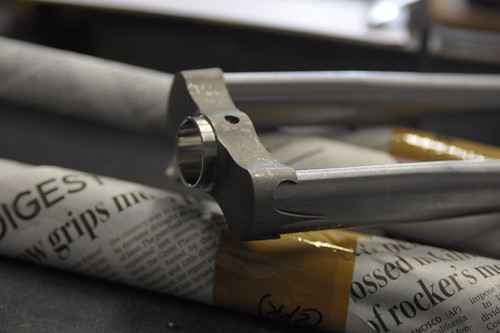
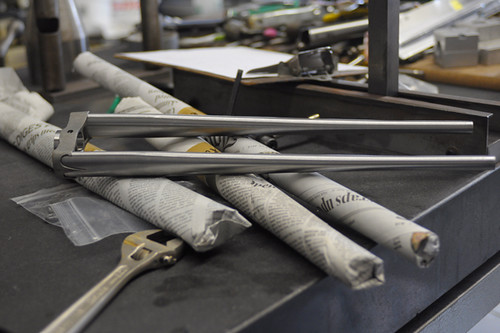
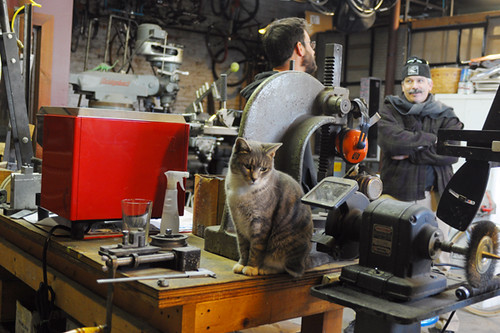
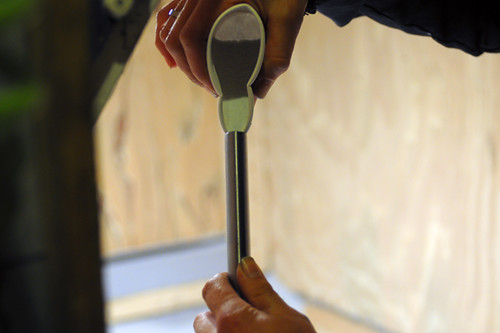
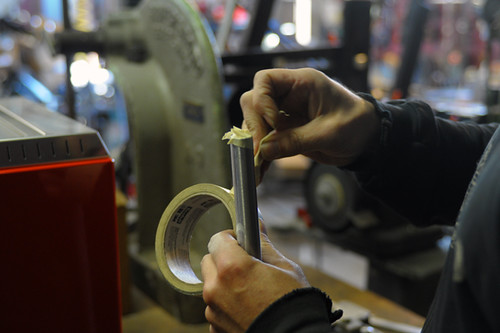

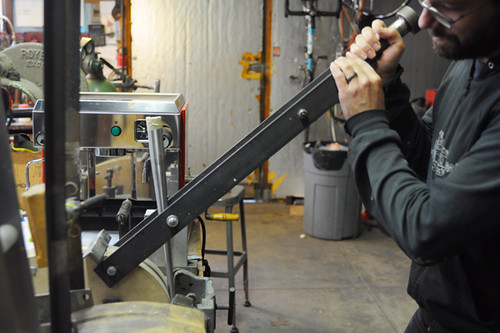
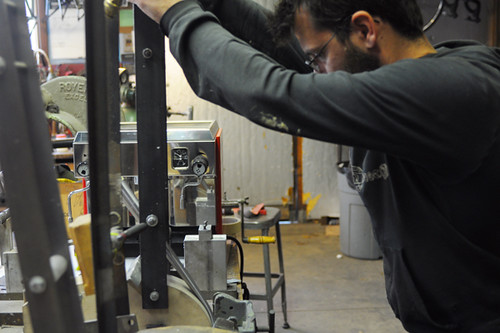
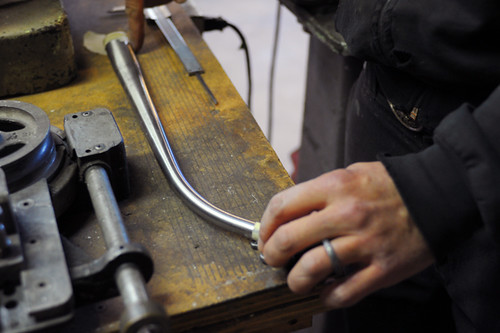

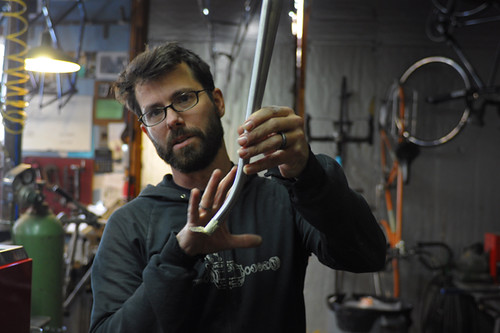
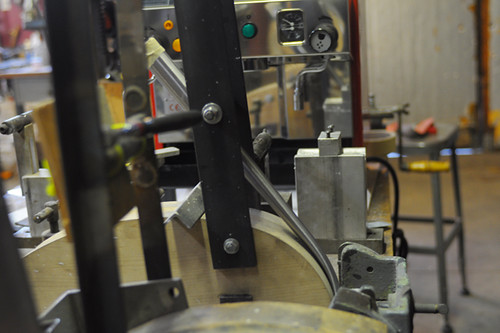
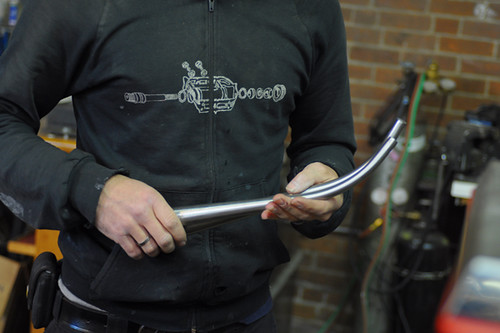
Hi, I was wondering what drove the decision for 73mm of rake?
ReplyDeleteWas it appearance? A certain ride quality? As you build your bike, please let us know some of the "why" reasons for doing things. I think it is interesting and would be glad to know some of the rationale.
I do know that my 1984 Basso Gap has a wonderfully compliant fork. I also consider it a joy to look at it. i.e the rake, contrast between paint and chromed dropout. The bike is full of little things like that that make it seem alive and have a personality unlike my Cervelo which just seems harsh and machine like.
Thanks!
I understand there are advantages to fork-rake such as dampening, etc. However, from purely the standpoint of trail, if you have straight fork blades that are bent at the top, you can accomplish the same trail.
ReplyDeleteI guess my question is, purely from a handling standpoint, are two bikes with everything equal *including* the amount of trail, but with different fork geometries (rake vs straight at an angle), going to handle the same way?
I want to know this as well, and might make an Alt Fork with same trail but banana bend at some point to test this out.
DeleteWe tested this and reported on it in Bicycle Quarterly about 5 years ago. We compared different forks and measured how much they deflected under a given weight. The biggest influence is the amount of offset and the diameter of the fork blades, but where the rake is located also seems to influence how much they deflect under load.
DeleteThanks Jan. As I was writing my post, I was thinking this was the type of thing Bicycle Quarterly would have. I subscribed to Bicycle Quarterly 2 issues ago so I missed this from 5 years ago.
DeleteSo am I correct that besides deflection, the trail number will tell the handling?
The impetus for my question is that most disc brake forks do not have rake, but still have trail (my guess is it has to do with the blades being able to handle the forces). I was wondering how they would compare.
Straight blade disc brake forks do have rake (i.e. the front axle is not in line with the steering axis, but some distance in front of it). It is just that the blades are angled at the crown rather than bent further down.
DeleteSo obviously the questions are: what is this bike supposed to do? How much weight is it designed to carry up front? Does the design preclude a rear rack and, if so, is tubing selected for this? Are there fork braze-ons for a rack? What size tires? Don't you have a Rawland that does most/all of these thing already? Why did you settle on a certain hta, having to change it due to the lugs? When you say this is "your" geo, how does it differ from the Rawland's?
ReplyDeleteetc etc
The bike is not new or remarkable in any way. Very similar to the Rawland & to last year's Royal H. collaboration. 650B low trail hbar bag etc. Mainly I wanted to make a frame that (1) I was already familiar with and had watched being made by others, and (2) would be sure to ride and stress. This seemed to be the best bet. Point of the exercise being to make the same old but this time try it myself, rather than to think up something new. The complexity + familiarity of the frame is great learning opportunity; I am getting a hand-on sense of pretty much everything from tricky clearance issues to various braze-ons, to limitations of lugged construction.
DeleteWhat?!? You did not try something completely different your first frame build? Oh the sensibility.
DeleteI am lazy, Matthew. Don't judge!
DeleteThe shape of the fork blades is very elegant. It would almost be a shame to paint them. Cant wait to see the whole frame when its done! I hope it rides well for you.
ReplyDelete"I am keeping things simple, and so naturally the bicycle I am making is a low trail design."
ReplyDeleteI don't see the connection. Can you explain?
Second question: do forks with much of the rake at the tips really flex more, and so provide more suspension, than other designs?
I made a little joke. The bike is pretty complicated.
DeleteSecond question: Supposedly, but it is debatable. I am doing it mostly because I want to stick with what is familiar and I've had good experiences with other bikes with such forks.
This is a very old and common technique employed when bending pipes and tubes in many industries. The force applied to the sand when bending is generally transverse rather than longitudinal and therefore the interference between particles is sufficient for it to remain in place.
DeleteMakes sense to have the lever pushed up rather than down. As pushing down is easier for most people, there is probably a somewhat greater chance of pushing too far.
ReplyDeleteAs I recall, Joel Greenblatt who made my Clockwork bike has his bender set up to push sideways. If I had seen this post before I visited his shop I would have known to ask why. Could be nothing more than his work area having a low ceiling.
That is very cool - I think it would really be something to be able to ride something like this that I created myself. I am envious (in a good way) and am going to enjoy watching this take shape for you.
ReplyDeleteCheers and good luck!
Wowzers! Nice tapering on the fork tube diameter. With a certain je ne sais quoi.
ReplyDeleteThis reminds me that I have to get around to getting the fork on my track bike repaired. It was ineptly drilled for a brake by the previous owner and the missing metal in the crown always gives me pause when I look at it (both for aesthetic and reserve strength reasons). It's also the only lugged and brazed frame components that I have!
ReplyDelete"That special kind of French curvy" .You're doing this deliberately.
ReplyDeleteI learn so much from you. Thanks for another great post.
ReplyDeleteReally neat project - I look forward to following your reports as you post them.
ReplyDeleteGreat topic! I get so excited when you cover a subject where I really have something useful to share! And when it comes to bending forks I have to think I'm like the Richard Sachs of it(fork bending)...
ReplyDeleteFirst of all, you don't need a fancy-pants jig, you can do it right on your existing bike AND you can do em' both at the same time! I did it, like, an infinity of times the summer I was 12, Here's how...
You take the blades you want to bend(new ones like you have or ones you hack-sawed off whatever un-dead zombie bike you have laying about), and you just pound them onto the ends of the fork on your bike(a sweet Stingray for choice) with a big hammer(you don't actually have to stop at one extra set at a time either, I've bent as many as 3 sets simultaneously to good effect) , then you install your front wheel on the new fork extensions and go ride around showing off your brand new Chopper! After an afternoon of wheelies, curb drops and bunny hops not only will you have a matched set of newly curved fork legs but you will have had a graduate level lesson in bike geometry theory and practice.
The attentive rider will be fascinated by the ever changing handling characteristics of the bike as it progresses from normal to low-trail, to NO-trail to negative trail to "what the hell is going on the pedals are dragging the ground and LEAVING a trail..." It's sort of a variable trail testing device except "Varying" doesn't quite seem like the right word somehow...
I can't recommend chopper riding enough as a way to really delve deeply into the subject of bicycle dynamics, I think there are things to be learned that just can't be demonstrated any other way. Plus chicks dig dudes on choppers.
Anyway, I guess you guys can bend forks however y'all want up there but this is how it was done "back in the day"(nostalgic chopper guy talk).
Spinndizzy
Love this blog. Before becoming a guitar maker I would have liked to learn to make bicycles. I have just taken to bicycles again as I take a break from luthery to care for my daughter and this is what I look at (and Sheldon Brown's site) sometimes while she is playing. Very much appreciated!
ReplyDeleteHow much freedom is there to recurve existing forks? Can the rake/trail be altered on an old fork to move in the direction of a low trail fork better suited to a handlebar bag?
ReplyDeleteIt can be done and there are people who do play around with adjusting offset on their bikes to tune things a bit. I understand that it was more common in the 40s and 50s when the cost of things encouraged people to modify rather than replace.
DeleteThere isn't a wide range of adjustment on an existing fork since the legs are a fixed length and any significant change is likely to drop the rim out of the brake pad adjustment range or push the tire too close to the fork crown. All the adjustment needs to be made in the bottom curved area and never at the area below the crown. I've recurved several damaged forks where the affected area was at the tips with good results and it would have been simple to add or subtract a bit and adjust the other to match.
I suspect that anyone who does much frame repair would be equipped to do this if they felt like it as they would have fork straitening tools that would be ideal(I always borrow the ones from my friend Les' shop and they get the job done nicely).
Spindizzy
BTW, there's always the other method I mentioned above...
It can be if you can find someone with a jig for bending forks. After bending the blades though, the axle-to-crown length of the fork is essentially shortened reducing tire/fender clearance or if the fork as cantilever studs, they may have to be moved.
DeleteSee Alex Wetmore's blog: http://alexwetmore.org/?p=473
DeleteNote that such additional bending does shorten the effective blade length a bit.
I tried re-raking on the cheap and easy with a Goodwill beater and ended up (of course) simply crimping the blades. Oh well, I never did like low trail handling or front loading.
I also came across this: nicest looking disk (K! K! K!) brake in the created universe.
Velouria: regarding higher trail = simple = joke: sorry, was being too earnest, a great sin of modernity.
http://alexwetmore.org/?p=1173
There is a lot of debate on this. Some say it's fine to re-rake a fork, while others claim trying to bend existing forks of unknown stress history can leave them too compromised. In other words, there's no way to know if a used fork has already experienced so much stress that it can remain strong after re-raking. At least one highly respected veteran frame builder that I know of is of this opinion.
DeleteAlso, I recently learned (from Velouria, in fact!) that blades are pre-rated for a rake "window". i.e., they are manufactured with the expectation to be raked up to a certain point, and not beyond. If the blade you want to re-rake has already been raked to the extent to which it has been rated, you don't want to exceed it by further raking.
Thanks for pointing that out Somervillain, you are absolutely right.
DeleteYou take your life in your hands anytime you try something like this but fortunately the safety factors on fork blades are high enough that if you are only moving things a small percentage of the existing offset your risk(a very REAL risk, however small) might be acceptable.
Interesting about the rake window, but spot on about unknown provenance.
DeleteSo...on my super expensive xxx bike that is made from metal to my dimensions so it should be great, and it is...I broke a chain stay. Bad batch of stays.
How does one know this? By the brand name? Short of doing a mass spectroscopy or whatever on it, it is impossible to judge the uniformity or purity of metal. Period.
Did the author of this blog go from "Eeek carbon fork!" to "Whatevs. I'll beta it. No big." very recently!?
If Circle A is bending this you should have had it done in a 57ish tt so I could've tested it. You're too light and cautious to due it justice.
Forks get bent in crashes. Then they get straightened. The crash bends are not done slowly with pretty tools.
DeleteGuys who straighten forks will sometimes say no, that one got bent too far. They play it conservative. Most anyone who straightens forks will work on forks bent far far beyond the current discussion of rake.
My Cinelli fork became a pretzel only a few months after I got it. Ron Boi at RRB hesitated a good long while before taking it in for repair. Then he thought about it some more. Then I rode it 70,000 miles
Great stuff - thanks for a great post.
ReplyDeleteI wondered how you plan to stress test your forks, or how you can be confident enough in the structural soundness to fly down hills at 40mph?
I've been speaking to a few framebuilders in the UK, and this seems to be a key current issue.
Do you mean that forks breaking are an issue, or stress testing in general? Builders who make one-off bikes don't stress-test them. They use known designs, tubing/blades that are rated for whatever it is they are being used for, and hope for the best.
DeleteUnless I do the braze poorly, there is no reason this fork should fail. It is a proven design that has been used by hordes of builders at this point on bikes that get ridden hard.
Granted, doing the braze poorly is a possibility. Forks are difficult, and many (possibly most?) reasonable people buy pre-fab forks or have a friend make them when doing their first builds. For this reason, the fork is the one place I am willing to accept lots of help including having Mike take over the braze if he sees I am struggling with the temperature control.
Also, to be clear, there are no forkS; just 1 fork made for personal use. I will stress the bike by riding it myself.
Plus you are building it from the IDEAL material given to us by the benevolent Cycle Gods, STEEL. I believe there is a passage in the book of Eddy that reads "Let the faithful construct their conveyances from steel, and steel shall be the material of the chaste and virtuous. Let no Person sink into iniquity by the indulgence of homebuilding crabon forks or striking an arc unto aluminum for use by the children of the wheel." Something like that.
DeleteSteel loves us and wants to keep us safe and happy.
Spindizzy
You got it. There's a guy in the UK who runs Bespoked Bristol (indy bike-builder show) who's also set up something called the UK Framebuilders Collective. The first thing on the agenda is how they can stress-test frames to pass EN Standards.
DeleteGranted, not really an issue if you're building a bike for yourself.
There's a brief thread on it here http://www.ukframebuilderscollective.co.uk/forums/index.php?topic=2.0 if you're interested.
Do you think the sand really does anything? Wouldn't it just get displaced by any really serious pressure? And wouldn't the pressure still stress the metal even if the sand prevented it from deforming it? I don't know, but having worked with metal for years in my youth, I somehow have my doubts.
ReplyDeleteSand actually works great as a support for forming tubing. It seems to pack relatively solid and is a well known and widely used method. Un-counted rollbars and cages were fabricated with this method for sportscars and Stock Cars before quality mandrel bending tools became affordable. It's still done this way by lots of guys who build their own racecars.
DeleteIt is also used for bending larger tubing with heat. I've bent sand filled D.O.M. tubing(with tight wooden plugs pounded in the ends to keep the sand firmly packed and in place) with wall thickness' over 1/4" this way with no other support and achieved smooth bends with constant radius' and minimal ovaling. When using heat on sand filled tubing the sand MUST be absolutely dry or the moisture turns to steam and you end up with a rather effective cannon firing splinters and sand all over your shop.
Spindizzy
That fork bending jig looks sort of home-made.
ReplyDeleteIs that true, or is there some kind of specialty tool manufacturer that caters to the frame building industry?
I know that metal fabrication shops have all kinds of fixtures/jigs for bending steel. Some are home-made, others are purchased from companies that deal in machine tools.
I agree that those gracefully curved fork blades look super. Thanks for sharing, and keep up the good work.
Freshly brazed forks are everywhere!!
ReplyDeletehttp://www.flickr.com/photos/22538785@N05/8163092274/in/photostream/
Velouria is right, by using a proven design, you know it is unlikely to fail. Not only are these ridden today, but they are based on classic designs that have worked for millions of miles over many decades.
ReplyDeleteIn addition, the fork crown has been laboratory-tested to meet the stringent EN standards for fatigue resistance. Kaisei blades also have ben tested by the tubing maker. Compass/Grand Bois is one of the few small makers who tests their products, both in the lab and on the road, before we offer them for sale.
Take a look at Russ forks or Bates Diadrant forks. Those have bends far sharper than anything contemplated here. I can't figure how those bends could be performed without crimping. But they were bent and they work fine.
ReplyDeleteIn ordinary fork curves there are plenty of extant elegant bends and small radius long rake blades made from plain carbon steel and fitted to lower-end production bikes. Look at older and cheaper Italian and French bikes and you will see them. There are plenty of cheap French bikes with rakes every bit as elegant as a Herse or a Csuka. It was never a matter of supreme craftsmanship as it was about just doing a lot of bending. Practice makes perfect. In the past decade the number of large rake steel blades produced has gone from near zero to maybe a hundred a year? When/if thousands are made it will all seem normal again and we'll see prettier bends than the attempts made now.
Proper placement of the fork blades in the vice seems critical. Notches tightly grasping the fork on either side must help, and perhaps a careful and slow start too. I can easily see myself bending the fork sideways :)
ReplyDeleteI'd be very interested to know how using the sand worked out. I've made several attempts using sand even brazing a cap on both ends and a hole with a nut brazed to it on the large end. Then I've filled it with sand through the nut placed a bolt in the nut and bolted it down as hard as possible into the sand to compress it. The apex of the 50mm rake still flattened by a mm. Did you have any flattening at all?
ReplyDelete